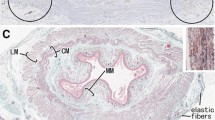Summary
Previous neurohistological studies have been extended to include the structures contained solely or mainly within the junctional esophageal segment which may play an important role in the sphincter mechanism. The main findings were: 1) a progressive cranio-caudal thickening of the muscularis mucosae; 2) a conspicuous thickening of the circular muscle layer; 3) abundant and close interconnections between the esophageal striated fibres and gastric smooth muscle cells; 4) presence of annulo-spiral elastic fibres coiled around bundles of striated musculature; 5) increase of the intramural nerve component, particularly Auerbach's plexus, which consisted of a continuous nervous layer containing twice as many neurocytes as found in the upper esophageal segments; 6) presence of numerous interconnected motor endplates often possessing ultraexpansional fibres and secondary endplates. The findings are discussed with emphasis on functional correlations in order to attain a unitary morpho-functional view.
Similar content being viewed by others
Abbreviations
- LES:
-
lower esophageal sphincter
- HPZ:
-
high pressure zone; mm: muscularis mucosae
- CNS:
-
central nervous system
- CCK-PZ:
-
cholecystokinin-pancreozymin
References
Baumgarten, H.G., Lange, W.: Adrenergic innervation of the oesophagus in the cat (Felis domestica) and Rhesus monkey (Macacus rhesus). Z. Zellforsch. 95, 529–545 (1969)
Botha, G.S.M.: Histological observations on the gastro-oesophageal junction in the rabbit. J. Anat. (Lond.) 92, 441–446 (1958)
Botha, G.S.M.: The gastro-oesophageal junction. Clinical application to oesophageal and gastric surgery. Boston: Little, Brown and Co. 1962
Bremner, C.G., Shorter, R.G., Ellis, F.H.: Anatomy of feline esophagus with special reference to its muscular wall and phreno-esophageal membrane. J. Surg. Res. 10, 327–331 (1970)
Bülbring, E., Gershon, M.D.: 5-Hydroxytryptamine participation in the vagal inhibitory innervation of the stomach. J. Physiol. (Lond.) 192, 823–846 (1967)
Califano, G.: Ricerche sulla struttura dell'esofago di coniglio. Osservazioni istologiche ed istochimiche. Quad. Anat. prat. 22, 197–214 (1966)
Cassella, R.R., Brown, A.L., Jr., Sayre, G.P., Ellis, F.H., Jr.: Achalasia of the esophagus: Pathologic and etiologic considerations. Ann. Surg. 160, 474–487 (1964)
Cecio, A., Califano, G.: Neurohistological observations on the oesophageal innervation of rabbit. Z. Zellforsch. 83, 30–39 (1967)
Cecio, A., Califano, G., Lobello, R.: Studio morfo-istologico dell'esofago di coniglio e considerazioni funzionali. Quad. Anat. prat. 29, 103–116 (1973)
Christensen, J.: Pharmacologic identification of the lower esophageal sphincter. J. clin. Invest. 49, 681–691 (1970)
Christensen, J., Dons, R.F.: Regional variations in response of cat esophageal muscle to stimulation with drugs. J. Pharmacol. exp. Ther. 161, 55–58 (1968)
Christensen, J., Freeman, B.W., Miller, J.K.: Some physiological characteristics of the esophagogastric junction in the opossum. Gastroenterology 64, 1119–1125 (1973)
Cohen, S., Harris, L.D.: The lower esophageal sphincter. Gastroenterology 63, 1066–1073 (1972)
De Carvalho, C.A.F.: Considerations on the muscularis mucosae and its relations with veins at the esophagogastric transition zone. Acta anat. (Basel) 78, 559–573 (1971)
De Carvalho, C.A.F.: Beitrag zur funktionellen Struktur der menschlichen Übergangszone Oesophagus-Magen. Anat. Anz. 130, 383–403 (1972)
Giordano-Lanza, G., Manieri, L.: Sulla costituzione anatomica e istologica della parete esofagea a livello dello hiatus diaframmatico e sui rapporti tra esofago e muscolo diaframma nel feto umano a termine. Quad. Anat. prat. 17, 192–211 (1961)
Grossman, M.I.: Hypothesis: gastrin, cholecystokinin, and secretin act on one receptor. Lancet 1970, I, 1088–1089
Gruber, H.: Über Struktur und Innervation der quergestreiften Muskulatur des Oesophagus der Ratte. Z. Zellforsch. 91, 236–247 (1968)
Irwin, D.A.: The anatomy of Auerbach's plexus. Amer. J. Anat. 49, 141–166 (1931)
Kadanoff, D., Spassowa, I.: Über die Formen der Ganglienzellen in den intramuralen Geflechten der Speiseröhre beim Menschen. Acta neuroveg. (Wien) 20, 19–32 (1959)
Köberle, F.: Pathological anatomy of enteromegaly in Chagas disease. Proc. 2nd Meet. Bockus Alumni Intern. Soc. Gastroenter., Rio de Janeiro, Brazil (1960)
Kosterlitz, H.W., Watt, A.J.: Adrenergic receptors in the guinea-pig ileum. J. Physiol. (Lond.) 177, 11–12 P (1965)
Mann, C.V., Shorter, R.G.: Structure of the canine esophagus and its sphincter. J. Surg. Res. 4, 160–163 (1964)
Pannese, E.: Sulla muscularis mucosae dell'esofago umano. Monit. Zool. Ital. 62, 146–153 (1954)
Rohen, J.: Über den funktionellen Zusammenhang zwischen glatter und quergestreifter Muskulatur im menschlichen Oesophagus. Anat. Anz. 102, 210–216 (1955/56)
Samarasinghe, D.D.: Some observations on the innervation of the striated muscle in the mouse oesophagus. An electron microscope study. J. Anat. (Lond.) 112, 173–184 (1972)
Smith, R.B., Taylor, I.M.: Observations on the intrinsic innervation of the human foetal oesophagus between the 10-mm and 140-mm crown-rump length stages. Acta anat. (Basel) 81, 127–138 (1972)
Venkatachalam, B., Da Costa, L.R., Ip, SKL., Beck, I.T.: What is a normal esophagogastric junction? Gastroenterology 62, 521–527 (1972)
Author information
Authors and Affiliations
Additional information
Dedicated to Prof. Dr. Wolfgang Bargmann for his fundamental contributions to Comparative Morphology
Rights and permissions
About this article
Cite this article
Cecio, A., Califano, G. & Lobello, R. Further histophysiological observations on the lower esophagus of the rabbit. Cell Tissue Res. 168, 475–488 (1976). https://doi.org/10.1007/BF00215998
Received:
Revised:
Issue Date:
DOI: https://doi.org/10.1007/BF00215998



